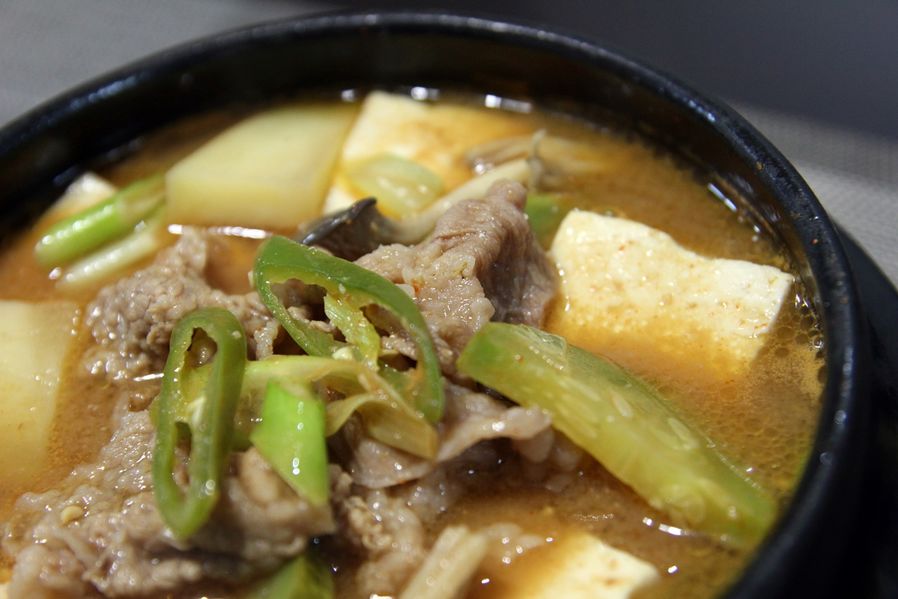1. Ingredients for Deonjang Jjigae
- Primary ingredients: Deonjang and water
- Secondary ingredients: Meat, seafood, pumpkin, potato, tofu, etc.
2. Taste evaluation
-Spicy: ☆☆☆☆☆
-Salty: ★★★★☆
-Sweet: ☆☆☆☆☆
-Sour: ☆☆☆☆☆
-Toasted flavor: ★★★☆☆
3. Introduction to Deonjang Jjigae (soybean paste stew) 된장찌개
Korean table basically consists of steamed rice such as rice and barley, soup called Jjigae, and side dishes. Given that Koreans commonly eat rice that is steamed without any seasoning, they prefer to eat soup that goes well with rice.
And the most popular soups among Koreans are Deonjang Jjigae and Kimchi Jjigae. I remember introducing Kimchi Jjigae before so I’ll introduce Deonjang Jjigae this time.
Deonjang Jjigae is a Korean soup cooked using Deonjang(Korean traditional paste), meat, seafood and vegetables. The secret to this food is Deonjang, Korean traditional sauce.
Deonjang representing Korean food has been used in so many cuisines for a long time. It was invented in Goguryeo Dynasty era, from which beans were originated, and it was very common that it was distributed to people during the years of famine in the era of the Three States.
Since Joseon Dynasty era, it was used in many cuisines regardless of social class that even soldiers were able to eat it as a side dish. The recipes have been developed since then.
Deonjang was made from Meju, steamed soybeans, in a traditional way but during the Japanese colonization in the late 19th centuries, there has been improved Deonjang that was affected by Japanese Miso. Currently, both of traditional Deonajang and improved Deonjang are used to make Deonjang Jjigae.
Traditional Deonjang with its unique taste is made by pouring salt water to Meju(steamed soybeans), putting it in the traditional storage called Hangari (pot) and leaving it until it ripens. In the process, it produces liquid, which is soy sauce, and the leftover solid ingredients are fermented to become Deonjang.
Japanese Miso and Chinese Dujang look and taste similar to Deonjang and they both are made in a similar way.
Deonjang has a unique scent like cheese and yogurt since it’s a fermented product. Although you might find it disgusting at first, it is getting all the attention from the world for its excellent anticancer effects.
Since Deonjang is fermented soybean, it has a strong and deep taste and very salty from salt water. This delicious and salty paste is used in many Korean cuisines.
People use Deonjang to make Deonjang Jjigae most of the time.
Deonjang is mixed with water and boiled with meat, seafood and vegetables in it.
It is quite salty yet tasty from Deonjang and various ingredients.
Deonjang Jjigae is not a classy food but a regular soup you can find on the dinner table in Korea.
So people eat this at home with their family than to eat it at a fancy restaurant.
It’s one of homemade foods in Korea.
And the table with hot Deonjang Jjigae reminds us of our mothers who would cook for us.
4. Kinds of Deonjang Jjigae
Deonjang Jjigae is made with anchovy broth boiled with Deonjang and various ingredients.
It might use meat or seafood, but never both at the same time.
You will see different kinds of it depending on ingredients used but the most common ones are pork Deonjang Jjigae, Chadolbagi(part of beef) Deonjang Jjigae, Haemul(seafood) Deonjang Jjigae, Dubu(tofu) Deonjang Jjigae and Hobak(pumpkin) Deonjang Jjigae.
5. How to enjoy Deonjang Jjigae even more
Jjigae, one of Korean soups, is characterized by many bits of ingredients and strong flavored sauce. Deonjang Jjigae is too salty to eat it alone so you’ll need to eat rice with it.
One interesting fact about Korean food is that the dishes are served at once, not in a specific order.
When you eat Samgyupsal (pork belly) or Galbi (ribs), Deonjang Jjigae and rice is served at the end just like the last dish.
Normally Italian or Chinese course menu starts with salads followed by main dish and meals.
Koreans eat meat and finish the meal with Deonjang Jjigae and rice at restaurants selling meat.
It’s also very cheap so I want you to enjoy the course menu at Korean meat restaurants.













